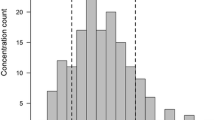Abstract
Posaconazole (PCZ) is given at 200 mg three times daily as a fungal prophylaxis in neutropenic hematologic malignancy patients. A relationship between exposure, plasma concentration, and efficacy is suggested. The objectives of this prospective study were to analyze the PCZ plasma concentration in hematology adults at high risk of developing invasive fungal infections (IFIs), and factors that could have an impact on the PCZ plasma concentration. PCZ plasma concentrations were measured after 2, 7, 10, 14, and 21 days of PCZ prophylaxis. Factors such as gender, age, body weight, posology, treatment duration, mucositis, proton pump inhibitor (PPI) use, and food intake were studied. Sixty-three patients were included, with a median age of 52 years (range 17–70) and a median weight of 75 kg (range 47–150). The median PCZ plasma concentration of the 63 patients ranged from 0.42 to 0.48 mg/L. At day 2, 30% of PCZ plasma concentration were under 0.35 mg/L, and at day 7, 74% were <0.70 mg/L. PCZ plasma concentrations were not affected by gender, age, body weight, or treatment duration. We found that food intake had a high influence on PCZ plasma concentrations (p = 0.0049). PCZ was well tolerated. One patient has developed a probable IFI, probably related to a low exposure to PCZ. PCZ therapeutic drug monitoring (TDM) is essential in order to early detect patients with low concentrations, to assess the etiology of such results, and to decide on the treatment strategy to apply.


Similar content being viewed by others
References
Cornely OA, Maertens J, Winston DJ et al (2007) Posaconazole vs. fluconazole or itraconazole prophylaxis in patients with neutropenia. N Engl J Med 356:348–359
Ullmann AJ, Lipton JH, Vesole DH et al (2007) Posaconazole or fluconazole for prophylaxis in severe graft-versus-host disease. N Engl J Med 356:335–347
Courtney R, Pai S, Laughlin M et al (2003) Pharmacokinetics, safety, and tolerability of oral posaconazole administered in single and multiple doses in healthy adults. Antimicrob Agents Chemother 47:2788–2795
Courtney R, Wexler D, Radwanski E et al (2004) Effect of food on the relative bioavailability of two oral formulations of posaconazole in healthy adults. Br J Clin Pharmacol 57:218–222
Krishna G, Sansone-Parsons A, Martinho M et al (2007) Posaconazole plasma concentrations in juvenile patients with invasive fungal infection. Antimicrob Agents Chemother 51:812–818
Gubbins PO, Krishna G, Sansone-Parsons A et al (2006) Pharmacokinetics and safety of oral posaconazole in neutropenic stem cell transplant recipients. Antimicrob Agents Chemother 50:1993–1999
Krishna G, Martinho M, Chandrasekar P et al (2007) Pharmacokinetics of oral posaconazole in allogeneic hematopoietic stem cell transplant recipients with graft-versus-host disease. Pharmacotherapy 27:1627–1636
Krishna G, AbuTarif M, Xuan F et al (2008) Pharmacokinetics of oral posaconazole in neutropenic patients receiving chemotherapy for acute myelogenous leukemia or myelodysplastic syndrome. Pharmacotherapy 28:1223–1232
Ezzet F, Wexler D, Courtney R et al (2005) Oral bioavailability of posaconazole in fasted healthy subjects: comparison between three regimens and basis for clinical dosage recommendations. Clin Pharmacokinet 44:211–220
Krishna G, Moton A, Ma L et al (2009) Pharmacokinetics and absorption of posaconazole oral suspension under various gastric conditions in healthy volunteers. Antimicrob Agents Chemother 53:958–966
Jang SH, Colangelo PM, Gobburu JV (2010) Exposure–response of posaconazole used for prophylaxis against invasive fungal infections: evaluating the need to adjust doses based on drug concentrations in plasma. Clin Pharmacol Ther 88:115–119
Walsh TJ, Raad I, Patterson TF et al (2007) Treatment of invasive aspergillosis with posaconazole in patients who are refractory to or intolerant of conventional therapy: an externally controlled trial. Clin Infect Dis 44:2–12
Lebeaux D, Lanternier F, Elie C et al (2009) Therapeutic drug monitoring of posaconazole: a monocentric study with 54 adults. Antimicrob Agents Chemother 53:5224–5229
Bryant AM, Slain D, Cumpston A et al (2011) A post-marketing evaluation of posaconazole plasma concentrations in neutropenic patients with haematological malignancy receiving posaconazole prophylaxis. Int J Antimicrob Agents 37:266–269
De Pauw B, Walsh TJ, Donnelly JP et al; European Organization for Research and Treatment of Cancer/Invasive Fungal Infections Cooperative Group; National Institute of Allergy and Infectious Diseases Mycoses Study Group (EORTC/MSG) Consensus Group (2008) Revised definitions of invasive fungal disease from the European Organization for Research and Treatment of Cancer/Invasive Fungal Infections Cooperative Group and the National Institute of Allergy and Infectious Diseases Mycoses Study Group (EORTC/MSG) Consensus Group. Clin Infect Dis 46:1813–1821
Andes D, Pascual A, Marchetti O (2009) Antifungal therapeutic drug monitoring: established and emerging indications. Antimicrob Agents Chemother 53:24–34
Rachwalski EJ, Wieczorkiewicz JT, Scheetz MH (2008) Posaconazole: an oral triazole with an extended spectrum of activity. Ann Pharmacother 42:1429–1438
Thompson GR 3rd, Rinaldi MG, Pennick G et al (2009) Posaconazole therapeutic drug monitoring: a reference laboratory experience. Antimicrob Agents Chemother 53:2223–2224
Moton A, Krishna G, Wang Z (2009) Tolerability and safety profile of posaconazole: evaluation of 18 controlled studies in healthy volunteers. J Clin Pharm Ther 34:301–311
Funding
No disclosures of funding were received for this work.
Author information
Authors and Affiliations
Corresponding author
Additional information
This work was presented in part at the 49th Interscience Conference on Antimicrobial Agents and Chemotherapy (ICAAC), San Francisco, CA, USA, 12–15 September 2009.
Rights and permissions
About this article
Cite this article
Eiden, C., Meniane, J.C., Peyrière, H. et al. Therapeutic drug monitoring of posaconazole in hematology adults under posaconazole prophylaxis: influence of food intake. Eur J Clin Microbiol Infect Dis 31, 161–167 (2012). https://doi.org/10.1007/s10096-011-1288-9
Received:
Accepted:
Published:
Issue Date:
DOI: https://doi.org/10.1007/s10096-011-1288-9




